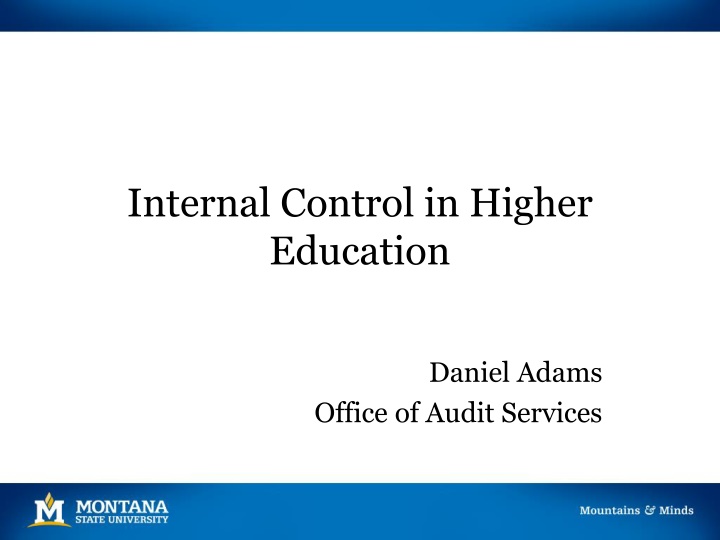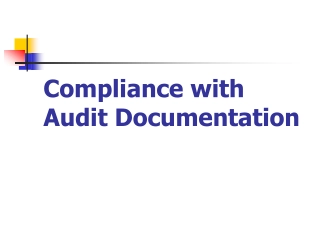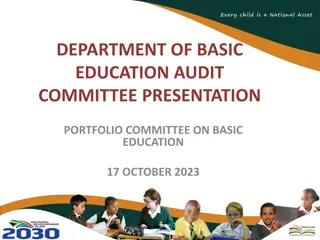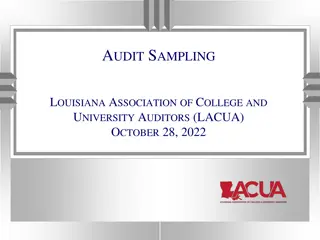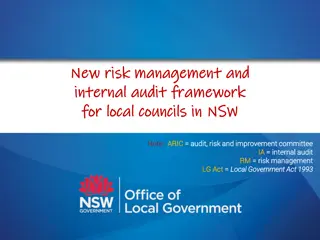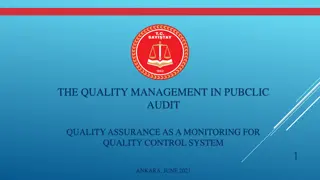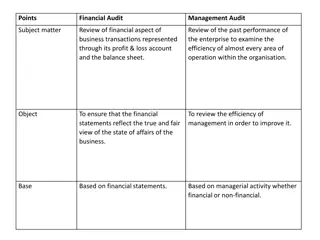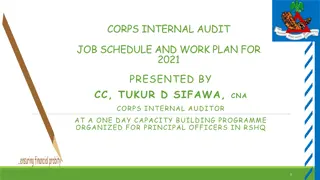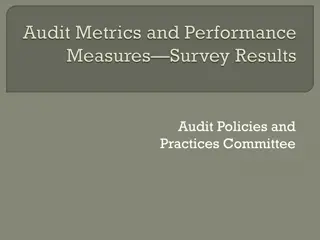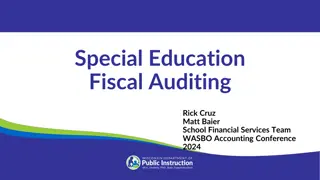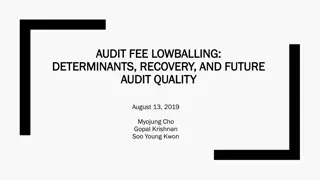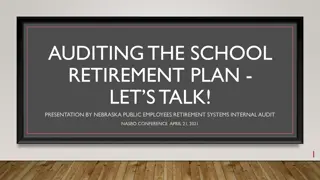Internal Control in Higher Education - Audit Services Overview
The content delves into the internal control practices within higher education institutions, focusing on the audit services provided by the Office of Audit Services. It discusses the mission, responsibilities, and key components of internal control, emphasizing the assurance and advisory services offered to enhance operations and mitigate risks. Additionally, it touches upon the Office of Management and Budget Circular A-81 and the three lines of defense for risk management in higher education settings.
Uploaded on Mar 13, 2025 | 1 Views
Download Presentation

Please find below an Image/Link to download the presentation.
The content on the website is provided AS IS for your information and personal use only. It may not be sold, licensed, or shared on other websites without obtaining consent from the author.If you encounter any issues during the download, it is possible that the publisher has removed the file from their server.
You are allowed to download the files provided on this website for personal or commercial use, subject to the condition that they are used lawfully. All files are the property of their respective owners.
The content on the website is provided AS IS for your information and personal use only. It may not be sold, licensed, or shared on other websites without obtaining consent from the author.
E N D
Presentation Transcript
Internal Control in Higher Education Daniel Adams Office of Audit Services
Audit Services Mission To provide assurance and advisory services that are independent, objective and risk-based in order to protect Montana State University and to improve its operations.
Audit Services Responsibilities Assurance services are objective examinations of evidence for the purpose of providing an independent assessment. Scope includes: Risks are appropriately identified and managed; The means with which assets are safeguarded; Employees follow policies, procedures, applicable laws, regulations, contracts, and governance standards; Source: Montana University System Internal Audit Charter
Audit Services Responsibilities Advisory services: counsel, advice, facilitation, and training Investigate suspected fiscal misconduct and review compliance hotline reports Source: Montana University System Internal Audit Charter
3 Lines of Defense for Risk Management (Institute of Internal Auditors Position Paper, January 2013) Management and Personnel Deans, Directors, Dept Heads, Faculty & Staff Risk and Compliance UBS, OSP, SRM, Info Security, Research Compliance Internal Audit
Internal Control in Higher Ed Overview 5 components and 17 principles of internal control Areas where internal control processes should commonly be implemented in higher ed Tools for assessing and improving internal control processes in your unit
Office of Management and Budget (OMB) Circular A-81 200.303 Internal controls. control over the Federal award that provides reasonable assurance that the non-Federal entity is managing the Federal award in compliance with Federal statutes, regulations, and the terms and conditions of the Federal award. The non-Federal entity must: (a) Establish and maintain effective internal
OMB Circular A-81 200.303 Internal controls. These internal controls should be in compliance with guidance in Standards for Internal Control in the Federal Government issued by the Comptroller General of the United States and the Internal Control Integrated Framework , issued by the Committee of Sponsoring Organizations of the Treadway Commission (COSO).
COSO Internal ControlIntegrated Framework COSO (Committee of Sponsoring Organizations) of the Treadway Commission American Accounting Association (AAA) American Institute of Certified Public Accountants (AICPA) Financial Executives International (FEI) Institute of Management Accountants (IMA) The Institute of Internal Auditors (IIA)
The Green Book Standards for Internal Control in the Federal Government Government Accountability Office (GAO) Comptroller General of the United States May also be adopted by state, local, and quasi-governmental entities as a framework for an internal control system Source: Standards for Internal Control in the Federal Government. GAO. September 2014.
Other Internal Control Frameworks Canadian Institute of Chartered Accountants Control Framework Control Objectives for Information and Related Technology (COBIT) International Organization for Standardization (ISO)
Green Book Internal Control Definition Internal control is a process effected by an entity s oversight body, management, and other personnel that provides reasonable assurance that the objectives of an entity will be achieved. Source: Standards for Internal Control in the Federal Government. GAO. September 2014.
Green Book Internal Control Definition These objectives and related risks can be broadly classified into one or more of the following three categories: Operations - Effectiveness and efficiency of operations Reporting - Reliability of reporting for internal and external use Compliance - Compliance with applicable laws and regulations Source: Standards for Internal Control in the Federal Government. GAO. September 2014.
Green Book Internal Control Definition Internal control comprises the plans, methods, policies, and procedures used to fulfill the mission, strategic plan, goals, and objectives of the entity. Source: Standards for Internal Control in the Federal Government. GAO. September 2014.
Green Book Internal Control Definition Internal control serves as the first line of defense in safeguarding assets. Source: Standards for Internal Control in the Federal Government. GAO. September 2014.
Green Book Internal Control Definition In short, internal control helps managers achieve desired results through effective stewardship of public resources. Source: Standards for Internal Control in the Federal Government. GAO. September 2014.
Who do you think is responsible for internal control at MSU?
Green Book Internal Control Definition People are what make internal control work. Management is responsible for an effective internal control system. However, personnel throughout an entity play important roles in implementing and operating an effective internal control system. Source: Standards for Internal Control in the Federal Government. GAO. September 2014.
International Organization for Standardization (ISO) Control Definition Administrative, managerial, technical or legal methods for managing risk, including policies, procedures, guidelines, practices or organizational structures Source: ISO 27000 Information security management systems.
ISO Risk Definition Combination of the probability (likelihood) of an event and its consequence (impact) Source: ISO 27000 Information security management systems.
OAS Risk Focus Compliance (Legal and Liability) Financial Information Security Operational Reputational Safety Strategic Source: http://www.montana.edu/audit/risk_rating_criteria.html
Characteristics of Higher Education Large organizations Offices with functional expertise (e.g., finance, sponsored programs, human resources) Decentralized Partially taxpayer funded Highly regulated Some managers do not have prior business-type experience
17 Principles Support the Five Components
Control Environment The oversight body and management establish and maintain an environment throughout the entity that sets a positive attitude toward internal control. Source: Standards for Internal Control in the Federal Government. GAO. September 2014.
Control Environment - Principle 1 The oversight body and management demonstrate a commitment to integrity and ethical values. 1. 2. Standards of Conduct 3. Adherence to Standards of Conduct Tone at the Top Source: Standards for Internal Control in the Federal Government. GAO. September 2014.
State of Montana Code of Ethics Gifts You may not accept a substantial (> $50) gift or economic benefit Self-Dealing You may not perform an official act which directly and substantially provides an economic benefit to a business in which you have a substantial financial interest https://hr.mt.gov/Portals/78/newdocs/guidesandforms/st andardsofconductguide.pdf
State of Montana Code of Ethics Unwarranted Privileges You may not: Contract or be employed within six months of termination by someone who contracts with the state involving matters with which you were directly involved during your employment with the state Receive two salaries as a public employee for work during overlapping hours https://hr.mt.gov/Portals/78/newdocs/guidesandforms/standar dsofconductguide.pdf
State of Montana Code of Ethics Public Property for Private Business Purposes You may not use public time, facilities, equipment, supplies, personnel, or funds for private business purposes. https://hr.mt.gov/Portals/78/newdocs/guidesandforms/st andardsofconductguide.pdf
Control Environment - Principle 2 The oversight body should oversee the entity s internal control system. 1. 2. Oversight for the Internal Control System 3. Input for Remediation of Deficiencies Oversight Structure Source: Standards for Internal Control in the Federal Government. GAO. September 2014.
Montana Code Annotated (MCA) 5-13-309. Information from state agencies. notify both the attorney general and the legislative auditor in writing upon the discovery of any theft, actual or suspected, involving state money or property under that agency's control or for which the agency is responsible. [ ] (3) The head of each state agency shall immediately http://leg.mt.gov/bills/mca/title_0050/chapter_0130/par t_0030/section_0090/0050-0130-0030-0090.html
Control Environment - Principle 3 Management should establish an organizational structure, assign responsibility, and delegate authority to achieve the entity s objectives. 1. 2. Assignment of Responsibility and Delegation of Authority 3. Documentation of the Internal Control System Organizational Structure Source: Standards for Internal Control in the Federal Government. GAO. September 2014.
Do you think authority and responsibility are clearly assigned at MSU?
Principal Investigator Guide 1110.00 Responsibilities in Post-Award Administration Office of Sponsored Programs Post-Award Responsibilities PI Post-Award Responsibilities Departmental Accountant/Business Managers Post- Award Responsibilities http://www.montana.edu/research/osp/documents/OSP_PI_ Guide.pdf
Documentation of the Control System Establishing and communicating who, what, when, where and why of internal control execution to personnel Means to retain organizational knowledge that could be limited to a few personnel Means to communicate effective control design to outside parties (e.g., auditors) Source: Standards for Internal Control in the Federal Government. GAO. September 2014.
MSU Policies and Procedures http://www.montana.edu/policy/ https://www.montana.edu/policy/hr_policies/index.html http://www.montana.edu/policy/business_manual/ http://www.montana.edu/policy/purchasing/ http://www.montana.edu/policy/property/manual.html http://www.montana.edu/research/osp/piguide/index.html
Guidance on Adequate Documentation Departmental Revenue Collection Procedures Model This document can be used by departments as a guide for the development or enhancement of their revenue collection procedures and can be tailored to each department s specific situation. http://www.montana.edu/audit/guidance.html
Control Environment - Principle 4 Management should demonstrate a commitment to recruit, develop, and retain competent individuals. 1. 2. Recruitment, Development, and Retention of Individuals 3. Succession and Contingency Plans and Preparation Expectations of Competence Source: Standards for Internal Control in the Federal Government. GAO. September 2014.
How well do you think MSU does at developing and training its people?
Control Environment - Principle 5 Management should evaluate performance and hold individuals accountable for their internal control responsibilities. 1. 2. Consideration of Excessive Pressures Enforcement of Accountability Source: Standards for Internal Control in the Federal Government. GAO. September 2014.
Risk Assessment Management assesses the risks facing the entity as it seeks to achieve its objectives. This assessment provides the basis for developing appropriate risk responses. Source: Standards for Internal Control in the Federal Government. GAO. September 2014.
Risk Assessment - Principle 6 Management should define objectives clearly to enable the identification of risks and define risk tolerances. 1. 2. Definitions of Risk Tolerances Definitions of Objectives Source: Standards for Internal Control in the Federal Government. GAO. September 2014.
Definitions of Objectives For quantitative objectives, performance measures may be a targeted percentage or numerical value. For qualitative objectives, management may need to design performance measures that indicate a level or degree of performance, such as milestones. Source: Standards for Internal Control in the Federal Government. GAO. September 2014.
Definitions of Risk Tolerances Risk tolerance is the acceptable level of variation in performance relative to the achievement of objectives. For financial reporting objectives, risk tolerance is typically expressed in terms of materiality. Source: Standards for Internal Control in the Federal Government. GAO. September 2014. Source: COSO Internal Control Integrated Framework. May 2013.
Definitions of Risk Tolerances Compliance objectives - Concept of risk tolerance does not apply. An entity is either compliant or not compliant. Source: Standards for Internal Control in the Federal Government. GAO. September 2014.
Risk Assessment - Principle 7 Management should identify, analyze, and respond to risks related to achieving the defined objectives. 1. 2. Analysis of Risks 3. Response to Risks Identification of Risks Source: Standards for Internal Control in the Federal Government. GAO. September 2014.
Guidance on Risk Assessment Internal Control Assessments These questionnaires were designed to make it easy for staff members to determine if their units have implemented many of the control activities that are commonly needed at MSU and are based on MSU and State of Montana policies and procedures and sound administrative practices. http://www.montana.edu/audit/guidance.html
